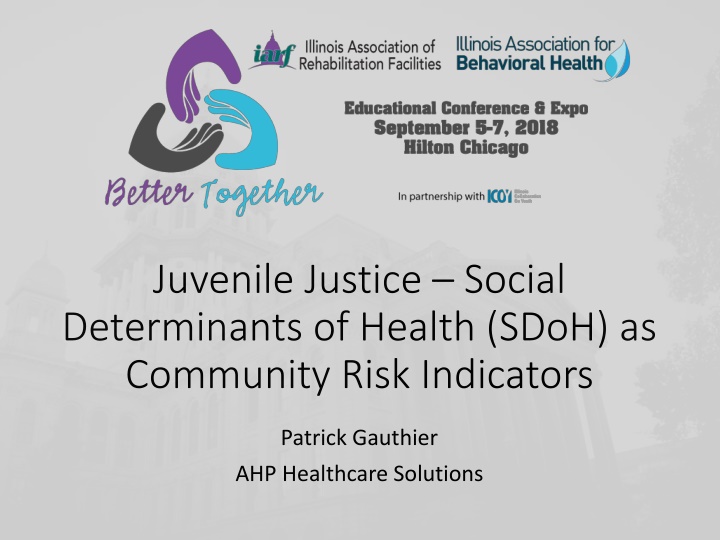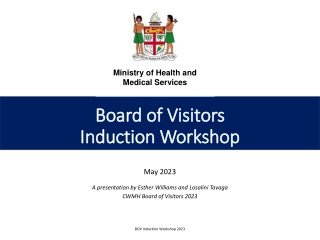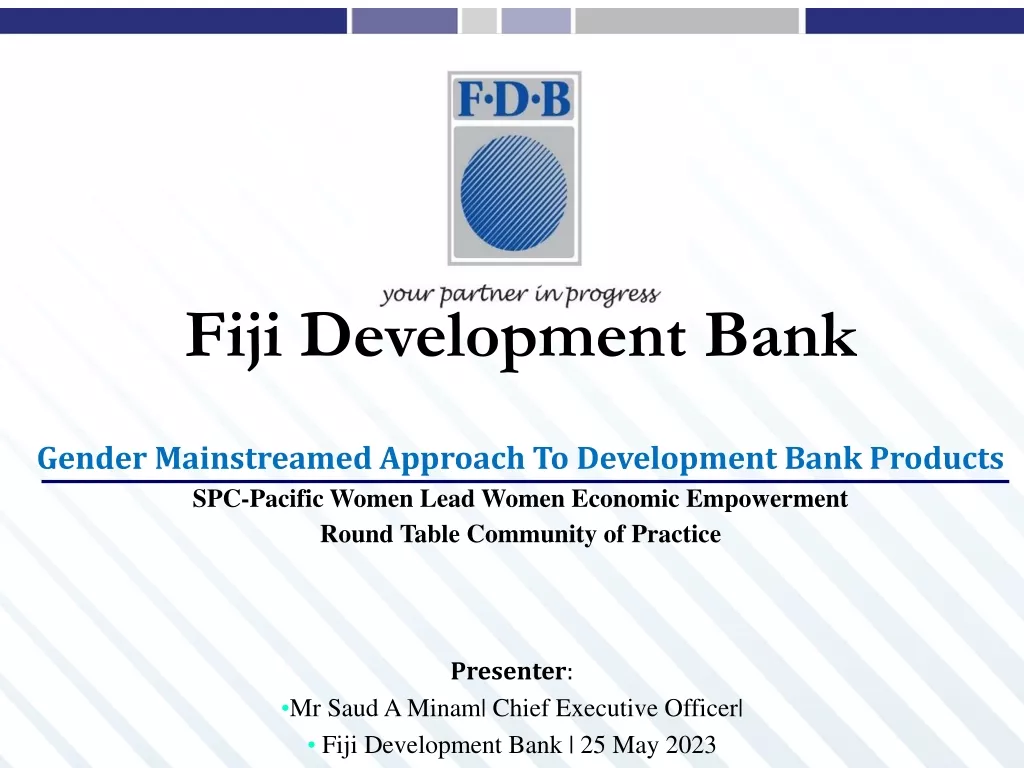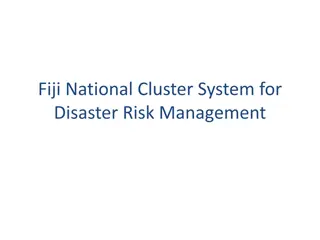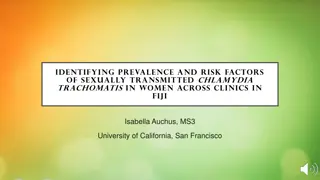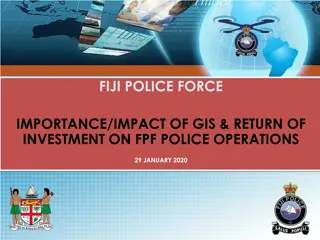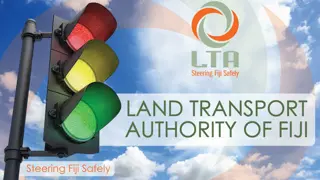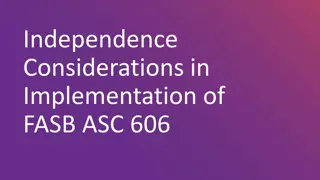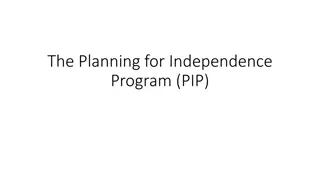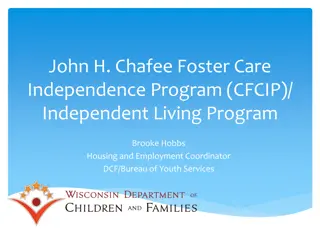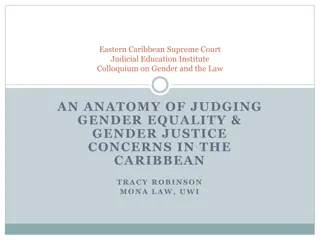Fiji's Journey to Independence
Fiji's path to independence in 1970 was marked by close relations with Britain and internal challenges. The country experienced population shifts, political uncertainties, and the beginnings of a multiracial democracy. Key figures such as Ratu Mara and S.M. Koya played significant roles, highlighting both cooperation and unresolved issues in postcolonial Fiji.
Uploaded on Apr 04, 2025 | 1 Views
Download Presentation

Please find below an Image/Link to download the presentation.
The content on the website is provided AS IS for your information and personal use only. It may not be sold, licensed, or shared on other websites without obtaining consent from the author.If you encounter any issues during the download, it is possible that the publisher has removed the file from their server.
You are allowed to download the files provided on this website for personal or commercial use, subject to the condition that they are used lawfully. All files are the property of their respective owners.
The content on the website is provided AS IS for your information and personal use only. It may not be sold, licensed, or shared on other websites without obtaining consent from the author.
E N D
Presentation Transcript
Juvenile Justice Social Determinants of Health (SDoH) as Community Risk Indicators Patrick Gauthier AHP Healthcare Solutions
Objectives 1. Know What - Understanding of Social Determinants of Health (SDoH) like Adverse Childhood Experiences as Community Risk Factors 2. Know Why - Understanding of Why SDoH Should be Measured 3. Know How - Understanding of How SDoH can be Measured and Reported
Cultural Relevance We all know programs and services should be culturally-relevant to and reflect the demographics of the state s young people, including: Race Ethnicity Religious affiliation Family status including foster care Housing status including homelessness Languages spoken at home Gender identity and sexual orientation Beliefs and moral code
Social Relevance Services should also be uniquely-tailored to the individual and be socially-relevant, reflecting: Adverse Childhood Experiences (ACE Scores) Household income and poverty Barriers to educational achievement Social connections Experience of violence in the home and community Exposure to environmental toxins Access to parks and recreational activities
Why? To the extent that we are experiencing an opioid epidemic, youth suicide crisis, surges in other drug abuse, and spiking STDs, Adverse Childhood Experiences (ACEs) are central to the despair at the root of the problems and central to designing solutions in our communities. Source: 2016 National Survey of Children s Health
ACEs Pyramid Implication: Children with the greatest needs/highest scores might be eligible for packages containing more intensive care coordination services, for example.
Why? Compared to youth with no ACEs, youth with 2 or more ACEs reported being Over 7 times more likely to experience emotional difficulties Nearly 8 times more likely to experience symptoms of depression in the past year Over 5 times more likely to have engaged in self injurious behavior Over 7 times more likely to have made a plan for how to attempt suicide in the last year Over 18 times more likely to have attempted suicide in the past year
Why? Compared to youth with no ACEs, youth with 2 or more ACEs reported being Over 3 times more likely to have had at least one drink of alcohol Nearly 6 times more likely to have gone to school or school events under the influence of alcohol or drugs in the past month Over 4 times more likely to have used marijuana in the past month
Why? Compared to youth with no ACEs, youth with 2 or more ACEs reported being Over 6.5 times more likely to have carried a weapon in the past month Over 4.5 times more likely to been in a physical fight in the past year Over 10 times more likely to carried a gun in the past year Nearly 3.5 times more likely to have been the victim of harassment at school in the past month
Why? ACE Scores are community risk factors that left unmitigated strain law enforcement, juvenile justice, emergency rooms, behavioral health providers, schools, foster care and many other agencies. Most of all, unmitigated ACE Scores strain and break young people, families and communities
Why? Incarcerated individuals are much more likely to have higher ACE scores, poorer SDoH, been exposed to violence, and suffer from PTSD A trauma-informed approach may better help to address some of these criminogenic risk factors and can create a less traumatizing criminal justice experience Juvenile courts better help deter children from crime and delinquency when they understand the trauma many of these children have experienced
Social Determinants of Health Household income/poverty Crowding Commute time Housing costs Unemployment Transportation Insurance status Educational attainment Language isolation Social isolation and loneliness Single-parent household Disability Pollution Access to parks Access to supermarkets and healthy foods Zip codes determining health status more than genetic code
Adverse Childhood Experiences ACEs commonly defined as 10 types of child abuse and neglect and family exposure to toxic stress are a complex population health problem with significant detrimental outcomes. ACEs are related to a range of poor adult outcomes, including increased risk of alcohol and drug use, mental health problems, poor physical health, and risky behaviors (Felitti et al. 1998). Toxic stress, associated with exposure to ACEs, disrupts neurodevelopment and leads to impaired decision making, impulse control, and resistance to disease; increase in adoption of risky behaviors; and early onset of disease, disability, and death (Center of the Developing Child at Harvard University 2016c).
Toxic Stress Exposure to severe, frequent or prolonged trauma without the adequate support Ongoing exposure to traumatic events in childhood disrupts brain development, leads to functional differences in learning, behaviors and health and is associated with both immediate and long-term impacts on health
Youth Risk Behaviors Survey These behaviors, often established during childhood and early adolescence, include: Behaviors that contribute to unintentional injuries and violence Prescription drug abuse Bullying/Cyber-bullying Adverse Childhood Experiences Sexual behaviors that contribute to unintended pregnancy and sexually transmitted infections, including HIV infection Alcohol and other drug use Tobacco use Unhealthy dietary behaviors Inadequate physical activity Source: Center for Disease Control http://www.cdc.gov/healthyyouth/data/yrbs/overview.htm
Community Risk Factors Early and Persistent Problem Behavior at home, school and in the community Family Conflict / Family Management Problems Friends Engaging in Problem Behavior / Weak Social Ties Lack of Commitment to School Family Exposure to Violence Gang Involvement Availability of Drugs / Drug Use Academic Failure Beginning in Late Elementary School Family History of Problem Behavior Low Neighborhood Attachment
Assets and Preventive Factors At least one non-parental adult who is there to help Family support Encouragement at school Sense of belonging to civic, community, school, sports, social or religious groups I matter to people in my community Volunteering at least one hour per week Sleeping at least 8 hours on school nights 60 minutes of physical activity daily at least 5 days per week
ACE Scores and Assets: an inverse relationship
Community awareness and investment in a Trauma-Responsive treatment system of care Mental health Substance use disorders Primary care Education and job preparation Juvenile justice system Housing Workforce Training in SDoH and ACEs Screening for SDoH, including them in treatment and service plans and measuring outcomes Specialized skills Caring for staff Collecting, monitoring and reporting data Using the data, responding to data Implications
Screening and assessment Treatment planning Care coordination, discharge and transition planning Case management Family involvement Overdose prevention Prevention of communicable diseases related to substance use and risky sex Relapse management for substance use and other cooccurring behavioral health disorders Medication-assisted treatment Family therapy and counseling services Psychiatric medication management Psychotherapy Juvenile justice system involvement and recidivism prevention Implications
Standards for connecting children, adolescents, young adults, and their families to relevant community and social services Support the individual s plan for the prevention, early intervention, and treatment of substance use and mental health disorders, including, but not limited to: housing health care coverage county/city social services vocational services literacy services parenting classes other supports as needed Implications
Community Health Needs Assessment Community Risk Factor Scores Youth Risk Behaviors Survey ACE Scores Implications Organizational Readiness Assessment System-wide Provider Capacity Gap Analysis Investment in filling the gaps System redesign Process Improvements Quality Improvements Outcomes Measures Return-on-Investment
Accessing state-sponsored trauma-informed practices and training opportunities Adopting trauma-specific evidence-based practices like Trauma Focused CBT Explicitly addressing historical trauma through culturally sensitive practices Strategies Involving individuals with lived experience Administering and using trauma-informed assessment tools as part of clinic practice Educating the public and using social marketing to increase awareness about trauma Sponsoring conferences to provide education about trauma and trauma-informed care Avoid retraumatizing clients and families
in Practice in Practice 1. Creating a culture of physical and psychological safety for staff and the people they serve Strategies 2. Building and maintaining trustworthiness and transparency among staff, clients and others involved with the organization 3. Utilizing peer support to promote healing and recovery 4. Leveling the power differences between staff and clients and among staff to foster collaboration and mutuality Conducting an organizational assessment of policies, practices and capacity to implement trauma- informed care? A list of free organizational assessment tools is available at http://www.t2bayarea. org/resource/grid/inde x.html 5. Cultivating a culture of empowerment, voice and choice that recognizes individual strengths, resilience and an ability to heal from past trauma 6. Recognizing and responding to the cultural, historical and gender roots of trauma
Gather community change capacity data: (1) Coalition capacity to develop and sustain a strong infrastructure, (2) network capacity to work collectively across sectors on community change, (3) capacity to plan and implement community-based solutions to address ACEs and resilience, and (4) community-wide capacity to empower the entire community to work at a scale to achieve community-wide results. Strategies
1. 2. Convene your coalition and share experiences Collective Community Capacity Index, which examines the community's capacity in areas such as: community partnerships shared goals leadership Infrastructure data use for improvement and accountability Communication community problem-solving processes diverse engagement and empowerment focus on equity multi-level strategies scale of work Collaboration on projects related to ACEs, resilience, and healthy child development Characteristics of the population, conduct the research and present the data; develop new models and present them to policymakers for consideration and approval/funding Strategies 3. 4.
Risk Stratification vis a vis Contracting All current stratification methods have their base in clinical variations; only a very small handful incorporate social determinants of health (SDoH) and their impact on medical conditions or care needs. Current risk tiering depends on data that exist in administrative (mainly billing) databases and medical records. Strategies Prediction of needs based on these data requires assumptions that may not be accurate when applied to children. Patterns of chronic conditions in children and the service needs associated with these conditions differ from those in adults; in addition, children s needs change more rapidly.
Risk Tiers The best tiering systems combine financially meaningful and clinically actionable characteristics (clinical pathways) Tiering itself works mainly to identify tiered risks and stratify cost as a first step Tying it to care coordination and increased services will both meet more needs for children and families and save money over time Need to improve tiering systems iteratively, using data and feedback about their performance
Key Questions 1. What are the relationships among medical costs, SDoH, and behavioral health in children? 2. How do these relationships vary from adults and how do they inform policy recommendations specific to children? 3. What measures exist or are needed to make tiering effective for payment and care models? 4. What are the roles of pediatricians, care teams and coordinators, parents/care givers, community resource providers, and payers in developing and executing service plans guided by tiering methods? 5. How are SDoH and/or behavioral health needs currently being integrated (if at all) into patient/family centered care coordination and community resource connection?
Key Questions 1. How well do current systems of care and care coordination services reflect the diversity of needs? How are these services measured and allocated? 2. How do integrating behavioral health and SDoH data into care coordination models improve their fit and prediction of service need? What changes are needed? 3. What is the current state of policy and practice about reimbursement to providers for providing SDoH and/or behavioral health oriented screenings, services, and coordination? 4. How can tiering models be financed across public coverage sources? What policy and payment trends might help or hinder efforts to get children and families what they need?
Key Questions 1. How do we correlate our SDoH data with other data like utilization/claims and outcomes data to tell a story of added value? 2. How do we use that data and that story to shape our systems?
Measuring SDoH Adverse Childhood Experiences (ACEs) CDC ACE Toolkit https://www.cdc.gov/violenceprevention/acestudy/ind ex.html Robert Wood Johnson Foundation, The Truth about ACEs. http://www.rwjf.org/en/library/infographics/the- truth-about-aces.html ACEs Connection. http://www.acesconnection.com/blog/aces-101-faqs The Center for Youth Wellness (CYW) ACE questionnaire https://centerforyouthwellness.org/cyw-aceq/
Measuring SDoH Center for Health Care Strategies https://www.chcs.org/resource/screening-social-determinants-health-populations-complex- needs-implementation-considerations/ Social Determinants Screening Tool (AccessHealth Spartanburg) Self-Sufficiency Outcomes Matrix (OneCare Vermont) PRAPARE Tool (Redwood Community Health Coalition) Community Paramedicine Pilot Health Assessment (ThedaCare) Social Needs Assessment (Virginia Commonwealth University Health System)
Additional Resources Youth Risk Behavior Surveillance System, CDC https://www.cdc.gov/healthyyouth/data/yrbs/index.htm The Center on the Developing Child, Harvard University. http://developingchild.harvard.edu/science/ The Community Resilience Cookbook. http://communityresiliencecookbook.org/your- bodybrain/
Additional Resources The Resilience Project, from the American Academy of Pediatrics Adverse Childhood Experiences and the Lifelong Consequences of Trauma, from the American Academy of Pediatrics Addressing Adverse Childhood Experiences and Other Types of Trauma in the Primary Care Setting, from the American Academy of Pediatrics The Medical Home Approach to Identifying and Responding to Exposure to Trauma, from the American Academy of Pediatrics Iowa ACEs 360 awareness resources, including media guidelines, press release and letter to the editor templates
Discussion Patrick Gauthier Director, AHP Healthcare Solutions pgauthier@ahpnet.com 508-395-8429
